Why Create a Webinar Series: Plan a Powerful Program in 8 Simple Steps

Maximize Your Marketing ROI
Join 10,000 other marketers already getting the best tips on running engaging events that boost pipeline and create raving fans.
Thinking about launching a webinar series? If you’re a digital or field marketer with big ambitions and a jones for creativity, it could be one of the best decisions you ever make.
Webinars are a popular, content-rich format for delivering your brand message. And in a perfect world, you’d be able to create more webinars—not less.
But the manual steps involved in planning a single webinar are already a bit too much for your to-do list, let alone an entire series of them.
Today we’ll look at the best ways to plan and execute a high-impact webinar series, without overburdening yourself or your team.
Here’s what we’ll cover:
- What is a webinar series?
- Why create a webinar series? Unlocking the benefits for B2B brands
- 5 all-star examples of a successful webinar series
- Plan a powerful webinar series in 8 key steps
First, what is a webinar series?
A webinar series is a set of multiple branded webinars hosted on a regular repeating schedule—for example, weekly, monthly, or quarterly. Each webinar can include different hosts, speakers, and attendees, but they are all united under a common theme.
While a single flagship webinar can often be the highlight of a broader integrated campaign, an ongoing webinar series helps marketers show up consistently on a key topic their audience cares about, diving deeper into the various components with each event in the series.
For example, at Goldcast, our Event Marketers Live series celebrates the people behind the scenes of our favorite B2B events. Individual sessions can cover a range of subtopics from hosting engaging lightning talks to using webinars to generate more ROI, and acing your event follow-up.
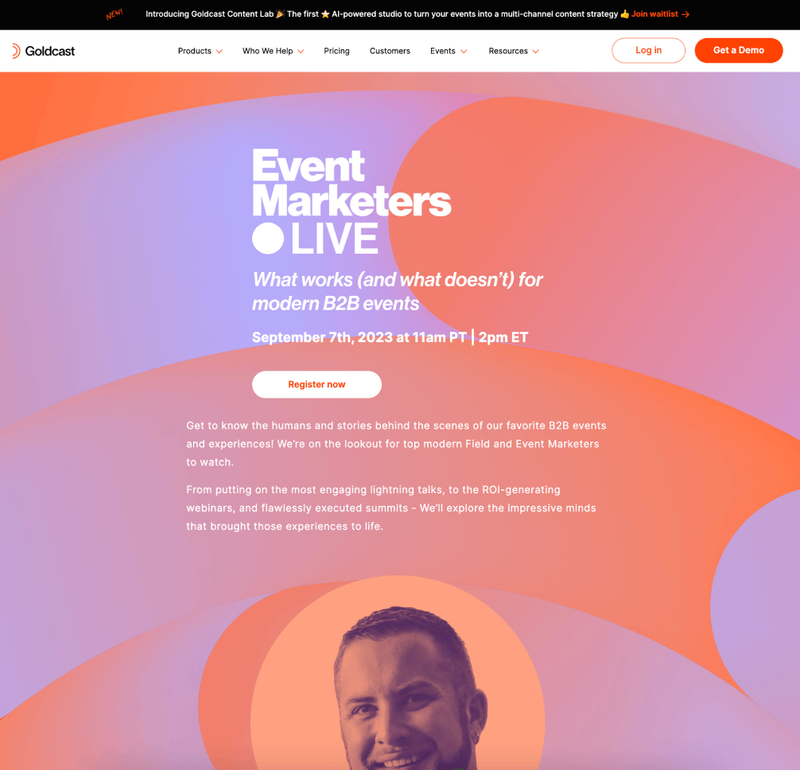
Why create a webinar series? Unlocking the benefits for B2B brands
One of the key reasons B2B event marketers love a webinar series is the versatility.
A strong webinar series can be targeted toward a specific part of the funnel, or used across the funnel to hit multiple marketing objectives with the same set of repeatable events.
We’ll share some examples of how that actually looks, but first, here’s a quick recap on the core benefits of a webinar series.
The top benefits of a webinar series:
- Widen your demand gen net. With multiple chances to learn and engage, a webinar series makes it easy for prospects to discover your brand when the timing is right.
- Get to know your audience. A webinar series gives you more opportunities to learn your audience’s real challenges, and develop custom content to meet their needs.
- Build brand authority. People trust consistency. By regularly showing up on important topics, a webinar series positions your brand as a reliable expert in the industry.
- Amplify your messaging. Repurpose your webinar content into always-on, easily consumable content, such as blog posts, video snippets, on-demand libraries, and more.
- Drive more attendees to your events. A recurring webinar series gives no-show registrants regular opportunities to connect at future events.
- Generate more leads and revenue. More attendees means more pipeline opportunities. 👍🏻
With multiple use cases and benefits, the webinar series is quickly becoming a B2B marketing favorite. But are they really that easy to execute?
We've been able to build up a following around our event series. We’ve never had that kind of repeatable event that people like before. That's a massive win for us.” Ashleigh Frank, Senior Demand Generation Executive at Cognism
5 all-star examples of a successful webinar series
Before we get into the nuts and bolts of creating your own powerful series, let’s take a closer look at some of the top webinar series from today’s best and brightest B2B brands.
In the section that follows, we’ll dive deeper into the concept and execution behind each. 😉
1. Validere’s monthly educational webinars
An educational webinar series focused on delivering thought leadership on key industry trends is a great way to build awareness in a new niche or category.
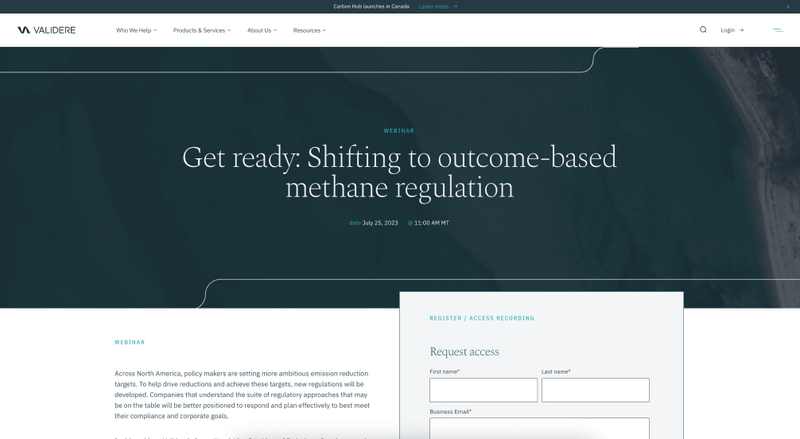
2. Zuora’s ‘What’s New’ customer update webinars
When it comes to customer marketing, a great webinar series can be just the ticket. You can share real product use cases, real user outcomes, and customer stories to inspire growth among your existing customer base.
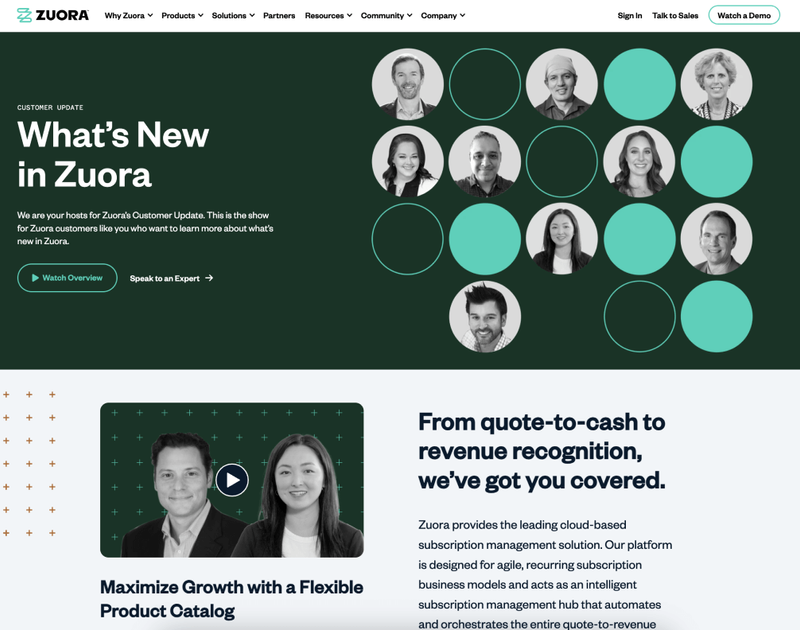
3. Cognism’s ‘Cold Calling Live’ series
A scalable webinar series isn’t just for the marketing team. Sales can get in on the action too!
Live training events providing hands-on help from your internal experts is an excellent way to build audience affinity.
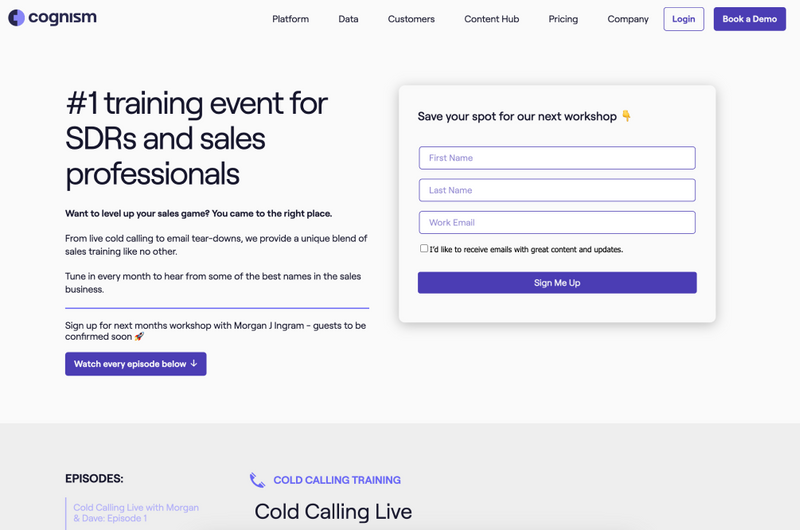
4. Drift’s ‘Drift In Action’ series
A digestible 30-minute webinar series covering the basics of using your product is a great way to provide consistent value to your audience.
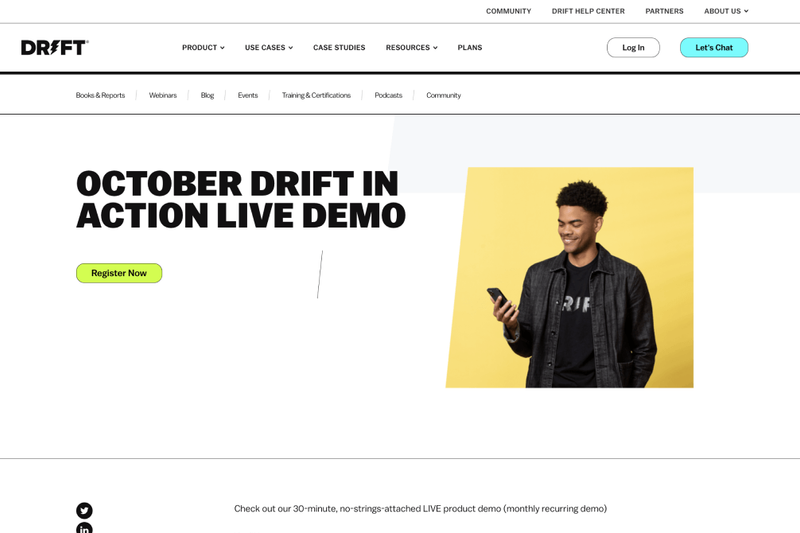
5. Goldcast’s ‘Event Marketers Live’ series
Using your webinar series to celebrate your community is always a mutual win. Attendees get the chance to learn from and connect with industry experts, without having to hop on a plane to an in-person event.

Plan a powerful webinar series in 8 key steps
You already know there’s a lot that goes into a well-planned webinar. But with the right approach, scaling your webinars into a powerful series of repeatable events can be a whole lot easier than you think.
Here’s how to plan an end-to-end webinar series launch, in eight simple steps.
1. Narrow down your audience
Validere is a measurement, reporting, and verification (MRV) platform that helps energy organizations transform data into actionable pathways to financial and environmental value.
A key goal behind the brand’s webinar series was to educate their audience and create awareness for the problem they solve. “Part of our effort is educating our audience that they have a problem to begin with—it's quite a new space we're in,” explained Tamara Teofanovic, Demand Generation Manager at Validere.
With a focus on carbon reduction and operational efficiency, she and the team at Validere needed a targeted way to connect with top executives at key accounts. They found their answer in a set of two webinar series specifically targeted toward their niche audience.
Here are some key points to consider as you pinpoint your own webinar series audience:
- How will this series speak directly to your ICP?
- Are there other internal influencers or decision makers who could benefit from your series?
- What part of the funnel will your series target?
- How will the series support your broader sales and marketing goals?
Today Validere’s webinar program delivers two events per month covering the top trends in energy and data management. Individual webinar topics cover a variety of issues—from day-to-day operational efficiency to the latest net zero developments.
By taking the time to get clear on the audience first, Tamara and the team at Validere have seen some amazing results from their webinars, including a 20% jump in attendance, an engagement rate increase of over 18%, and a 6% increase in MQLs.
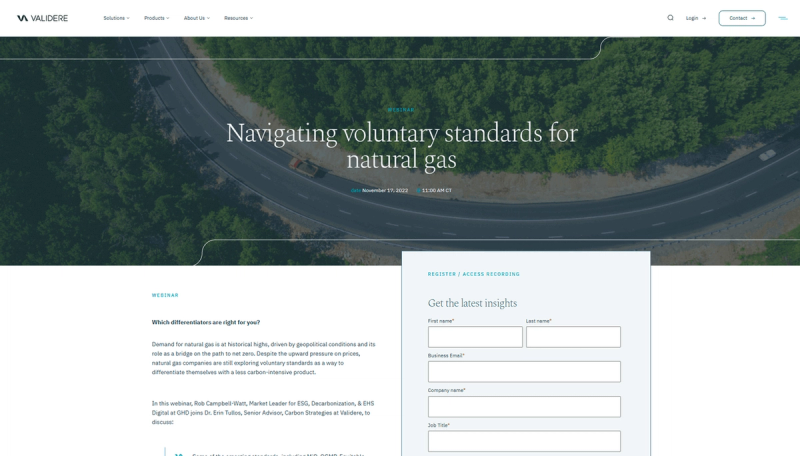
2. Brainstorm your theme and title
At leading subscription and monetization platform Zuora, events aren’t owned by just one team. Instead, they’re a fundamental way of achieving departmental goals across all stages of the funnel.
When it comes to brainstorming the theme, content and title for your webinar series, start by understanding how it fits into your broader funnel and event strategy.
Here are some questions to get the wheels turning:
- Top-of-funnel: What type of event experience will help you build awareness and thought leadership on an ongoing basis?
- Middle-of-funnel: Which webinar formats will help drive product and campaign-specific awareness?
- Bottom-of-funnel: How can your webinars solve problems and deliver demos in an organic environment?
“One of my favorite things that we've run really consistently for our customer base is our customer update series that we run quarterly,” explained Haley Ferrante, Director, Digital Programs at Zuora.
“It's called What's New in Zuora and it's very curated in saying, ‘How do we want to present this information? How do we continue the story of what we did last time?’ Because it’s a series. It's not presented in a way where you have to register for all of them or go to the first and the second.”
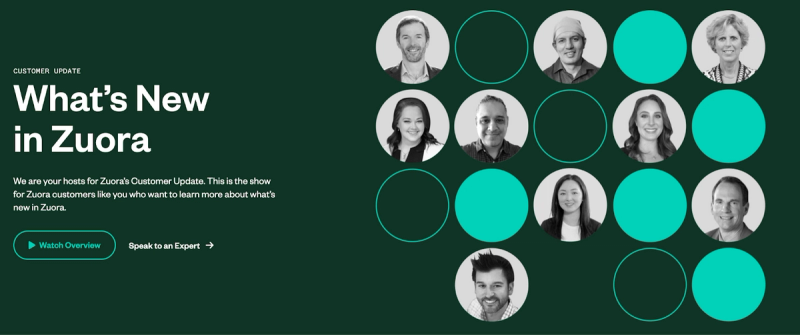
💡Tip: A straightforward title can be a great way to go for your webinar series. Just make sure you don’t use the actual word “webinar”. Our research has shown an almost 50% drop in registration when people see "webinar" in the event name.
3. Select your event platform
Digital and field marketers are never short of items on their to-do list. With so much going on, staying consistent with a webinar series may feel like mission impossible.
But with the right platform, you can easily replicate a high-quality webinar experience in a fraction of the time.
Here are a few of the key features to look for in your webinar platform:
- High quality video production features
- Multiple attendee engagement features (video Q&A, 1:1 chat, live polls, and more)
- Strong tech specs and support
- Customizable branding (landing page, emails, and more)
- Event analytics
- Key platform integrations
For Tamara and the team at Validere, after a year with an out-of-the-box webinar platform, they knew it was time to take their webinars from “basic” to “professional and polished.” So when she registered to attend a Goldcast webinar and instantly received the calendar invite, she immediately forwarded it to her director. “I was like, ‘How did they do this?’”
Before you choose your event platform, take time to list the features you’ll need in order to run a successful webinar series. (And if you’re curious about what Goldcast can do for you, check out our latest customer wins or reach out to our team for a personalized demo. 😉)
Goldcast allows us to deliver a live webinar that looks polished. It’s completely branded and looks so good, we actually take the recording and use it again elsewhere with no additional editing required. This is something that was missing with other webinar platforms.” Tamara Teofanovic, Demand Generation Manager at Validere
4. Create a streamlined webinar workflow
The right webinar platform can shave hours off your prep time, but you’ll still need a strong workflow to keep your webinar series on track.
For Andrea Chow, Senior Field Marketing Manager at ClickUp, she uses a pre-built webinar template covering all the crucial event tasks:
- Getting a speaker for the event
- Building content
- Creating social posts
- Creating sales assets
- Securing Q&A support
- And more
“How I'm able to scale and create events is essentially through a webinar template where I'm able to create tasks and see an overall plan of, ‘Hey, I need to build content, I need to build social posts and get graphics. I need speakers, right? I need assets for sales’. I'm able to go to the task and see my objective.”
In the task, which she of course tracks in Clickup, Andrea adds in the event details and tags the product marketing and sales team to get their feedback on the event content.
A streamlined workflow behind the scenes empowers Andrea the ClickUp team to execute some pretty creative ideas as part of their ongoing ‘ClickUp with Your Clique’ webinar series—including beer tastings and even virtual lego builds.
“I like to do these sorts of things...being able to have that balance of fun, creativity and getting that product in there to help our sales team create and accelerate new opportunities.”
💡Tip: Grab our free webinar checklist to easily create and customize your own streamlined workflow, or take a closer look at Andrea’s checklist below. ⬇️
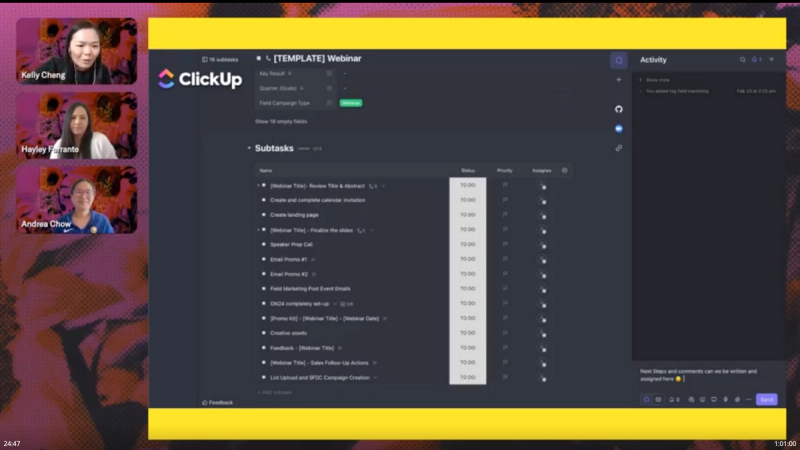
5. Promote your webinar series
One of the great (but also terrible) things about webinars is the fact that there are so many ways to promote them.
Rather than focusing on all the ways you can build awareness for your webinars, aim to pinpoint your most effective webinar promotion channels.
At Goldcast, we’ve found that B2B marketers often get the best results from promoting their webinars via the following channels:
- Social media
- Employee enablement
- In-app promotions
- Communities and creators
Of course, it also doesn’t hurt if there is more than one team or department getting in on the event action.
At leading sales intelligence platform Cognism, each team has its own live event series. The Cold Calling Live series is a live training event hosted by the Cognism sales team. Demandism is a monthly webinar diving into all things B2B demand gen marketing led by Cognism’s marketing team.
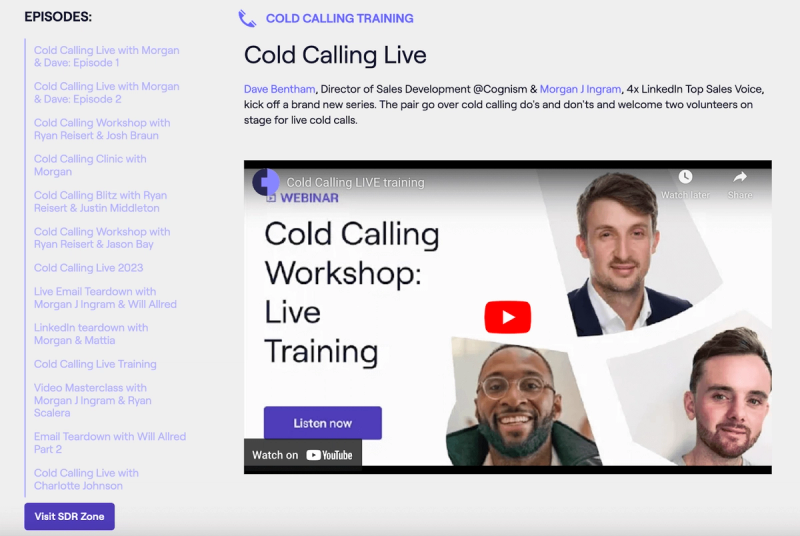
With a scalable webinar workflow, it’s easy for multiple teams to host events, leading to a virtuous webinar promotion cycle across a wider network of attendees.
6. Launch first episode
If you’ve narrowed down your audience, theme, platform, workflow and promotion strategy—congrats! You’re ready to launch your first episode. 🎉
Before a webinar becomes a webinar series, it’s usually a good idea to treat the first episode as a test. The goal is to secure objective data to make sure the content resonates with your audience and can help you reach your marketing goals.
Of course, you also want to do everything you can to make sure the pilot episode of your new series is a hit.
Here are some ways to make sure your first episode makes a splash:
- Choose a big name speaker to headline your webinar
- Make sure the topic is “hot” and timely
- Amplify your efforts on your best promotion channels
- Track attendee engagement data to measure your success
Once you’ve got a clear picture of your registration, show rate, and engagement score, you’ll be in a much better position to decide whether investing in future episodes is really worth your time.
Here’s how Andrea from ClickUp decides if a webinar is worth scaling into something more:
“Because I'm a field marketing manager, I really look at the sales pipeline that's generated from these marketing virtual events or webinars. That breaks down to leads, meeting opportunities, and trying to see if that total value is at least 20x the amount of spend I put into a webinar.”
With constant pressure on event marketing budgets, she knows measuring ROI is key to maintaining leadership buy-in for her webinar series and events. The right data on the right first episode can give you everything you need to maintain that crucial buy-in.
If I see the number of opportunities is a reasonable number for the total pipeline, I can easily justify that this content resonates and maybe we should try to continue this style of webinar.” Andrea Chow, Senior Field Marketing Manager at ClickUp
7. Distribute your webinar content
As part of their focus on brand awareness, Cognism’s Senior Demand Generation Executive Ashleigh Frank is committed to creating targeted content for each of their ICPs—and content from their webinar series is key to making that happen.
“We ask ourselves, ‘Can this poll inspire us to make more content down the line?’ If the answer is yes, step one is putting it up on our podcast.”
With the right event platform, you can easily repurpose your webinar content into the following formats:
- Social media posts
- On-demand content previews
- Promotional material for future events
- Blog posts
- Outreach emails
- Event summaries
- And more
To 10x her event strategy, Ashleigh and the team are particularly focused on using past events to promote future events. “We make short videos, one to two minutes in length, from the most relevant or interesting parts of the webinar and turn that into content for LinkedIn, blog posts, YouTube videos, and ads.”
Whatever your content distribution goals, a steady stream of valuable webinar content can help make them happen.
8. Systemize your process
Once you’ve got your concept down, it’s time to rinse, repeat, and keep scaling your events.
“Scaling up your webinar series is so much easier when you can copy and paste, change the dates and times, and keep the same format,” explains Sara Lieber, Senior Event Marketing Manager at Drift.
With a little help from Goldcast, Drift has vastly expanded its webinar program.
Sara and her team are able to easily execute one webinar per week. The increased volume and variety of Drift’s webinars have been directly linked to a more engaged prospect and customer audience—with little additional time investment. “We’re all trying to get a lot done, and Goldcast adds some time back to your day.”
Here’s a quick breakdown of Drift’s webinar series lineup:
- Product Deep Dives -Customer-only sessions led by Drift’s product team.
- Drift In Action - 30-minute sessions on the basics of Drift Conversation Cloud.
- Demo Day Live - Demos highlighting product capabilities that impact businesses right away.
- Sales User Training - Sessions featuring best practices and configuration tips for selling with Drift.
The simplicity of the platform means other departments can handle their own setup, with Sara and her team only providing support when needed.
“Other teams are excited to be able to get out in front of our audiences and speak to things that are top of mind for them. Enabling other teams to use Goldcast has been a huge help in empowering them to do the presentations they want to do.” - Sara Lieber, Senior Event Marketing Manager at Drift.
Challenges of starting a webinar series (and how to get ahead of them)
While these straightforward steps may make planning a webinar series seem easy, the truth is it’s not without its challenges.
Here are some of the common roadblocks you may come up against, plus tips to overcome them:
Booking guests
With a webinar series, the pressure to deliver a steady lineup stellar speakers is strong. If you already have a brand community, tap into your member base to see who might make a great future speaker. You can also set up a speaker registration page with a quick questionnaire to help you collect information and select your best speaker candidates.
Keeping content fresh
Right now, you might be brimming with ideas for your webinar series. A few months down the line, it may be a completely different story. Be sure to incorporate engagement elements like polls and Q&A to regularly collect insights on future topics straight from your target audience.
Repurposing content
No one has time to rewatch multiple webinars per week. Whether you use Goldcast or another platform, look for webinar software that includes an Events Hub for your on-demand library and AI tools to help repurpose and amplify your content.
Keeping up with the cadence
Consistency is key to a successful webinar series. Make sure your templates are easy to replicate and customize for seamless execution on a regular basis.
Your webinars, your way: Plan the perfect webinar series with Goldcast
The beauty of creating a webinar series is that there is no wrong or right way to go about it.
Simply keep your concept grounded in the real needs of your audience, and you’ll have everything you need to amplify your brand narrative and increase your event ROI.
When you’re ready for an event platform partner that gets it, our team of event experts is here to help.

Transform Your Video Marketing with AI
Stay In Touch
Platform
Resources
© 2025 Copyright Goldcast, Inc. All rights reserved.





 Upcoming Events
Upcoming Events Event Series
Event Series On-Demand Events
On-Demand Events

